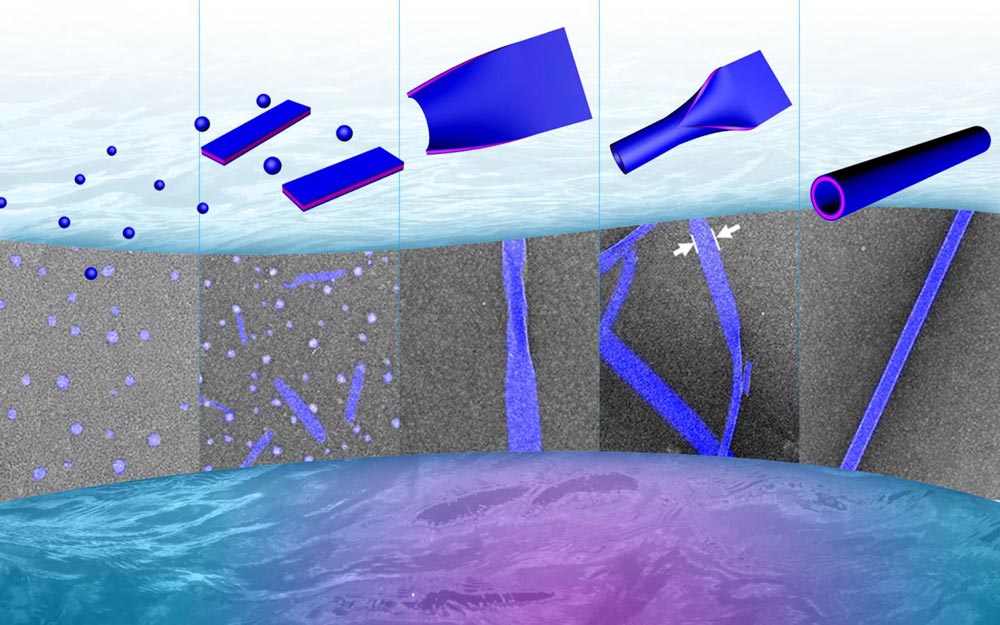

Scientists at PNNL have created a new family of nanotubes that are composed of peptide-like molecules called peptoids. These nanotubes start out as small droplets that come together to form a cell-membrane-like sheet. Then the sheet folds at one end and zips closed into a tube.
Credit: PNNL
Materials scientists, led by a team at the Department of Energy's Pacific Northwest National Laboratory, designed a tiny tube that rolls up and zips closed.
These hollow nanotubes are thousands of times smaller than a strand of human hair and could help with water filtration, tissue engineering and many other applications.
The tubes were inspired by protein structures called microtubules that reside in cells, according to PNNL's Chun-Long Chen.
“The structure of the cell is so beautiful,” said Chen, a materials chemist who conceived of and directed the project. “We wanted to create a synthetic system that mimics the microtubule structure and is stable enough for a variety of technical applications.”
Chen, his PNNL colleagues and their collaborators published their findings this week in Nature Communications.
Mimicking microtubules
Microtubules are tiny hollow tubes that help keep DNA organized during cell division and form highways for shuttling contents around in the cell.
These cellular roads are composed of long chains of proteins that come together into a rigid, but hollow, tube. Microtubules have a uniform but dynamic structure, and they inspire scientists like Chen.
Chen's group hopes to use tiny hollow tubes like microtubules to create a robust water filtration system that would catch salt or other molecules inside and let pure water escape out the other end. In addition, they want to monitor how stem cells adapt to different environments by studying how the cells change while they grow on these tubes.
But the researchers can't use microtubules themselves for these projects. Microtubules may be rigid and responsive, but they're also susceptible to temperature changes and microbes.
For example, “if we want to use microtubules for water filtration, you don't want to have a filter that can be eaten by bacteria,” said Chen.
So the team set about making a synthetic version of microtubules using protein-like molecules called peptoids. Like proteins, peptoids are composed of a repeating pattern of building blocks with slight variations, but peptoids are more stable.
These new nanotubes form in a unique way. First, small peptoid particles come together to form a sheet. Then the sheet closes at one end and rolls into a seamless tube.
Nano toolkit
To characterize the nanotubes, the scientists used a variety of techniques, including some at the Advanced Light Source and the Molecular Foundry, two DOE Office of Science User Facilities at Lawrence Berkeley National Laboratory.
Chen and his team discovered that these nanotubes are highly tailorable. The group could control a tube's size, diameter, thickness and stiffness by adjusting the tube composition or changing the acidity of the solution.
To test the rigidity of the nanotubes, Chen's team put pressure on individual nanotubes and measured how they changed shape. The tubes have a rigidity that falls between biological tissue and harder substances like glass and mica, which, said Chen, is great for the types of experiments he hopes to do.
But Chen doesn't want to stop there. For him, the goal is to create something that mimics nature in structure and function.
“Nature has offered us all kinds of beautiful examples,” he said. “Fish can take in water from the sea without having to worry about high salt conditions. If we could mimic this behavior by building artificial cell membranes containing these nanotubes, we could solve some of the big problems facing our world today.”
###
This work was supported by the Department of Energy Office of Science, PNNL and the National Science Foundation of China.
Reference: Haibao Jin, Yan-Huai Ding, Mingming Wang, Yang Song, Zhihao Liao, Christina L. Newcomb, Xuepeng Wu, Xian-Qiong Tang, Zheng Li, Yuehe Lin, Feng Yan, Tengyue Jian, Peng Mu, Chun-Long Chen. Designable and Dynamic Single-Walled Stiff Nanotubes Assembled from Sequence-Defined Peptoids, Nature Communications, Jan. 18, 2018, DOI: 10.1038/s41467-017-02059-1.
Interdisciplinary teams at Pacific Northwest National Laboratory address many of America's most pressing issues in energy, the environment and national security through advances in basic and applied science. Founded in 1965, PNNL employs 4,400 staff and has an annual budget of nearly $1 billion. It is managed and operated by Battelle for the U.S. Department of Energy's Office of Science. As the single largest supporter of basic research in the physical sciences in the United States, the Office of Science is working to address some of the most pressing challenges of our time. For more information on PNNL, visit the PNNL News Center, or follow PNNL on Facebook, Google+, Instagram, LinkedIn and Twitter.












